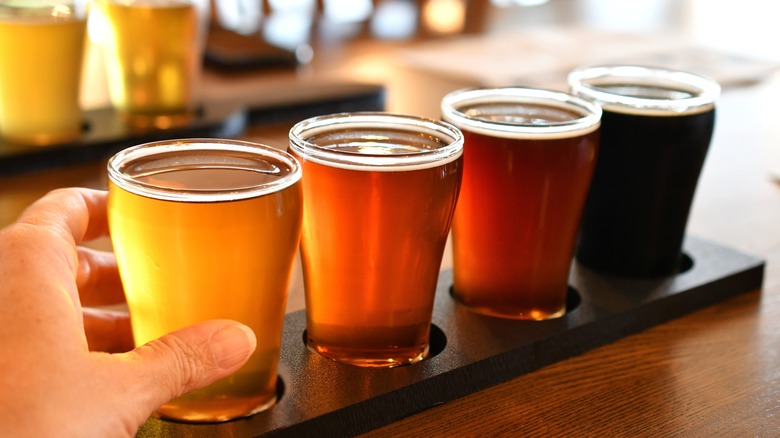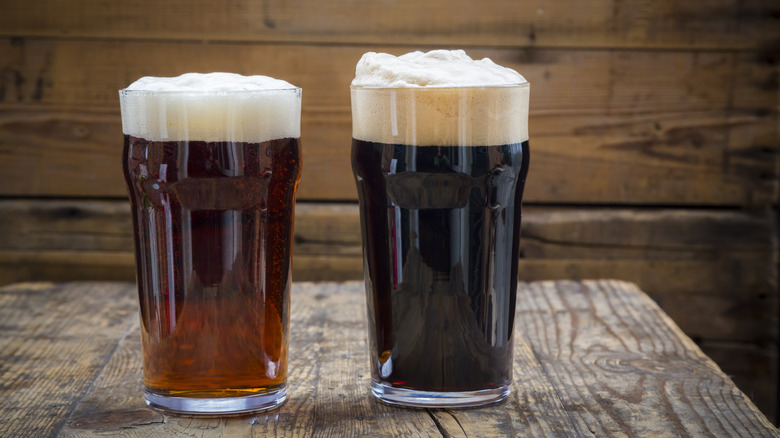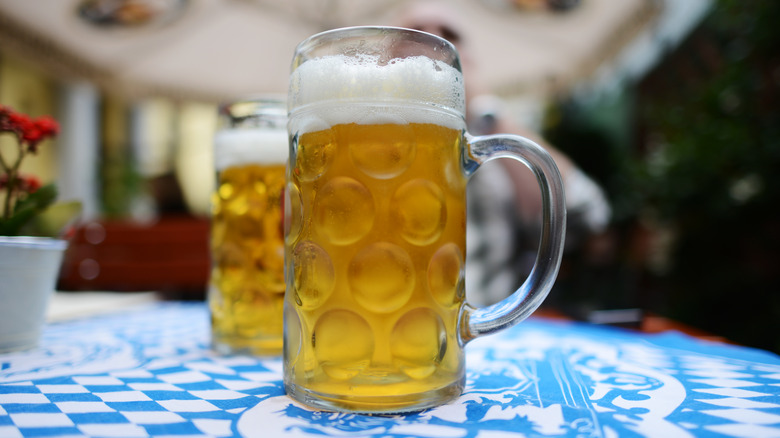What Is The Flavor Difference Between An Ale And A Lager?
If a beer expert walks into a brewery, they probably have no issue picking out their favorite drink and knowing which kinds suit their tastes and which ones don't. But to a beer novice, it can be challenging to know where to start when there are so many options. India Pale Ale? Pilsner? Witbier? Kölsch? What are these beverages and what on earth is the difference? To understand brewery lingo, you must first know that most beers belong to one of two categories: ales and lagers.
Pinpointing a specific flavor difference between the two gets complicated, since beers that are both in the same category can taste wildly different from each other. For example, India Pale Ales (IPAs) and Porters are both ales, but IPAs are bold and hoppy with hints of fruits or spices, while Porters are dark and robust, and can be brewed with coffee or chocolate. To understand the differences between ales and lagers, you must understand the differences in how they are made.
What is an ale?
Ultimately, the difference between an ale and a lager has to do with the type of yeast involved in the brewing process and the temperature during the fermentation process. Ales use top-fermenting yeast (Saccharomyces cerevisiae, to be specific), and require warmer temperatures to ferment, usually between 60 and 70 degrees Fahrenheit. The yeast is called "top-fermenting" because the heat causes it to rise to the top of the brewing vessel, creating an impressive layer of foam. The warmer temperatures also contribute to a quicker fermenting time of only about three to five weeks.
Depending on the type of ale you order, you will get flavor profiles that are fruity, hoppy, roasty, or spicy, and this has to do with the esters — or flavor compounds — released by the specific yeast strain used during fermentation. The higher temperatures cause more of these flavor compounds to be released, resulting in a brew that punches you with flavor. If this sounds intriguing to you, knowing other types of ales besides IPAs and Porters can help you broaden your beer horizons. Pale ales, brown ales, amber ales, stouts, witbiers, and Kölsch all fall under the ale umbrella.
What is a lager?
In contrast, lagers use bottom-fermenting yeast (typically Saccharomyces pastorianus). The fermentation temperatures are significantly cooler than those used to make an ale, with lagers fermenting between 35 and 50 degrees Fahrenheit. These lower temperatures mean the yeast sinks to the bottom, as opposed to shooting to the top and creating foam. The whole process is much slower, and lagers can take months to ferment. Colder temperatures also mean that less esters are released, which brings us to our key difference in flavor profiles between ales and lagers.
While all the varieties of ales have very distinct flavors, lagers are usually described as clean, crisp, or easy to drink. When you think of drinking an ice cold, refreshing beer on a hot day, you're probably thinking of a lager. For example, Corona is a popular lager brand, and nothing hits quite like a Corona with lime on a scorching summer day. Dunkels, bocks, and pilsners are other examples of lagers.
Generally speaking, lagers have a smooth, mellow taste with a hint of sweetness that even people who aren't the biggest beer fans can tolerate. On the other hand, ales are heavy-handed on the unique flavor profiles, and may not be everyone's cup of tea (or ... beer). So next time you walk into a brewery that has what seems like a hundred choices, you'll at least know to start with either the crisp, refreshing qualities of a lager, or the bold, unique flavors of an ale.


